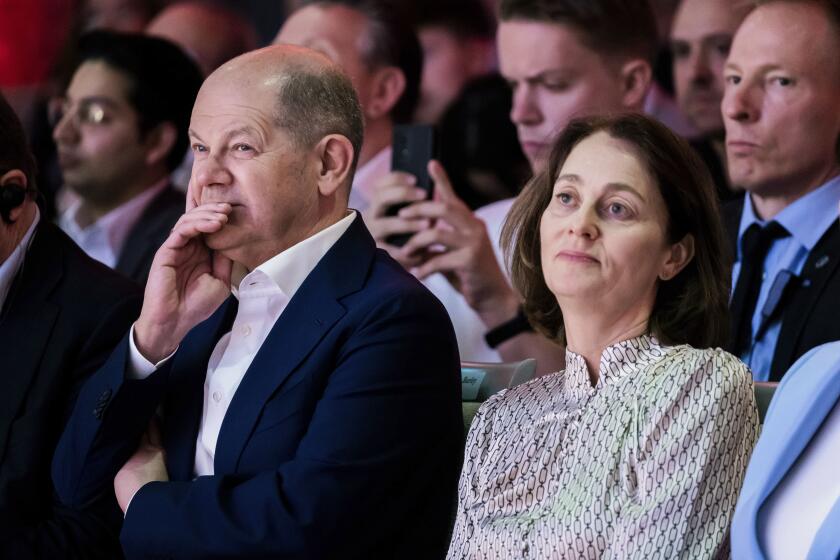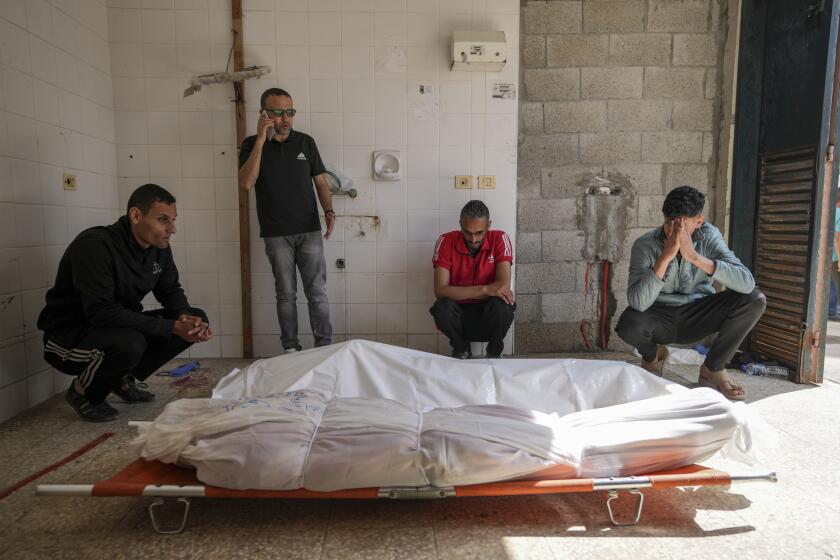Combat in the Time of Small Phones
As an Army private in World War II, Clifford Long landed in the initial waves of four key Pacific Island invasions, but he wasn’t there to shoot at the enemy.
Instead, Long and fellow radiomen in the Signal Corps lugged telephone lines, switchboards, batteries and other heavy, bulky gear to shore. Then they rolled out trunk lines to command posts and local lines to the troops so officers could relay tactical information as quickly as soldiers advanced under the leadership of Douglas MacArthur.
“I always worked with Gen. MacArthur, and he always softened up the beach for us” with long-range bombing, recalled Long, 79, a retired New York City deputy fire chief living in Englewood, Fla.
Through millennia of warfare, field communications have been crucial to directing assaults, coordinating attacks and simply calling for help. And spurred by the likes of AT&T; Corp., Motorola Inc. and General Dynamics Corp., no aspect of war has changed as dramatically.
Today in Iraq, the array of gear that strained the backs of Long and his men in the Pacific can fit into a squad leader’s pocket. Dispatches that once traveled along copper lines -- or, before that, by horseback -- are encrypted and bounce off satellites to transmit detailed graphics, video and data, as well as voice.
Mobile satellite stations fit in Humvees, and command post centers, where computer monitors display up-to-date maps of U.S. forces, real-time video and photos taken by unmanned planes, can be taken down and moved within hours as the front advances.
“We had none of this in Desert Storm,” said Marine Col. Nick Petronzio from a command post in Iraq, referring to the 1991 campaign to liberate Kuwait. The information transmitted to his post ends up on computers on a U-shaped desk called the “Killing U,” where strategy is plotted.
Tomorrow’s technology: combat gear that integrates a complete communications system -- voice, data and video through microphone headsets, hand-held computers and monitors hanging from helmets.
“We have thermal sights on rifles that can see through smoke and fog and we have laser targeting on rifles, but they’re not yet in a system that is integrated with other communications,” said Susan Pasternack, manager of General Dynamics’ strategic business integration unit.
General Dynamics won a $60-million military contract two months ago to start creating an integrated Land Warrior package that would give every soldier communications gear that includes personal electronics and global navigation. Commanders not only would know where every soldier is but also would be able to see what the soldiers see through their rifle sights or other hand-held devices.
That’s a far cry from what was available 85 years ago, when AT&T; workers were drafted into the American Expeditionary Force to string copper wire throughout France so commanders could keep in touch with troops fighting World War I, the so-called war to end all wars.
Slow-moving trench warfare gave the Signal Corps time to hang wires from trees and poles to the front, connecting them to the crank-box telephones and telegraph machines of the day. “French lines were overtaxed and not up to the standards expected for our needs,” said AT&T; historian Sheldon Hochheiser.
‘Hello Girls’ and Pigeons
The Signal Corps also asked AT&T; for operators to run the system. “There still were no dials on telephones,” Hochheiser noted. Because the military lines connected to France’s civilian network, the 213 women sent as operators -- they were called the “Hello Girls” -- had to be bilingual.
World War I troops also relied on another system: carrier pigeons in the Signal Corps’ 600-bird Pigeon Service. One of its members, Cher Ami, earned the French Croix de Guerre medal. Although shot through the breast by enemy fire, the bird returned to his loft with a message from the 77th Infantry Division’s Lost Battalion, which had become isolated behind German lines. Cher Ami’s effort led to the rescue of 194 men.
As radio broadcasting and two-way radio technology evolved in the 1920s, the military did little at first to upgrade battlefield communications.
“America demobilized after World War I to an extent not seen at any point after World War II,” Hochheiser said. “The military wasn’t doing much in the 1920s and ‘30s, so we weren’t doing much with the military. The country slipped back into isolationism.”
In the next global war, the U.S. entered the conflict in 1941 with much of the same wired communications it relied on in the last, though this time it added heavy Teletype machines and wireless radio phones to the battlefield mix.
On Basilan Island, off Mindanao in the Philippines, Long and his crew got a lesson in age-old wartime communications. As troops moved inland about 100 yards from the beach, they heard a group of natives approaching from the jungle playing fife, drum and bugle -- sending messages as the British did in the Revolutionary War.
“Maybe 60, 70 Filipinos came out to tell us how many Japanese were on the island, and they said they would get them if we could give them some guns,” Long said.
While Signal Corps crews were hooking up combat phones on Pacific islands, Tech. Sgt. Bill DeYoung, with his Teletype machine boxed in a wooden crate on a truck, was racing through France with Gen. George S. Patton. The troops were moving so fast, he recalled, that Signal Corps linesmen laying wires along the road for phones and Teletype couldn’t keep up.
“We used radiophones and messengers in jeeps to communicate with the command post,” said DeYoung, 84, a retired electrician living in Grand Rapids, Mich. “The radiophone was a little different. We could use voice over it but didn’t because it wasn’t secure. Messages could be intercepted. We used Morse code.”
Patton and his troops finally stalled in Verdun because they had nearly run out of gasoline; in a sign of the crucial nature of field communications, the gas that was available was saved for generators powering the Teletype machine.
World War II witnessed a number of technological inventions and military adaptations of commercial products.
Chicago manufacturer Paul V. Galvin, visiting troops overseas, saw the trouble they had communicating from the front lines. His Galvin Manufacturing Co. already was producing wireless car radios branded as Motorola -- a combination of the words “motorcar” and “Victrola,” the popular phonograph.
The company, renamed Motorola after the war, created for soldiers the first hand-held two-way radio: the 5-pound Handie-Talkie, which like all amplitude modulation, or AM, sets suffered from static and interference.
In 1942, the company started producing 135,000 portable FM walkie-talkies, 35-pound logs that soldiers lugged in backpacks. The frequency modulation models could carry voice more clearly and much farther than AM -- usually five miles but sometimes as far as 20 miles.
Cell-Phone Forerunner
Walkie-talkies were the forerunners of cellular telephones, pagers and modems and helped turn Motorola into one of the world’s largest makers of cell phone handsets and equipment.
Motorola also became a major contractor for military and space communications, with government sales reaching 25% of total revenue by 1954. Galvin and his heirs, however, always viewed federal contracts as a non-core small business conducted for the good of the country. Motorola sold the 3,000- employee operation 18 months ago to General Dynamics for $825 million.
The United States entered the Korean War with much of the same sort of equipment the military used in World War II, but soldiers found that wired telephone circuits were impractical. Rugged hills hampered relay teams, and relay trucks were targets of guerrilla warfare and sabotage.
For the first time, the wireless radio became a key communications device, thanks in part to a new technology called very high frequency. The VHF radio was more dependable than wired phones, but the Signal Corps continued to lay copper down for the preferred -- and more secure -- telephone system.
The enemy “are shooting all over, and those crazy Signal Joes are going on laying lines like nothin’s happening,” according to one infantryman quoted in two military reports.
With the dawn of the Space Age in the late 1950s, the Signal Corps began experimenting with satellite communications. The corps found that voice and Teletype signals could be sent to an orbiting satellite, which could receive them and send them back.
But that didn’t help the troops much in the 1960s and ‘70s in Vietnam, where the communications infrastructure was inadequate at best and in many places nonexistent.
Dan Hassett, trained to use hand-cranked field phones, went to Vietnam in 1967 as a telephone lineman instead and saved himself a lot of backache: The radiophone used in combat then weighed about 30 pounds and was carried in a backpack, he remembered.
As a lineman, though, he faced enemy fire, especially during the 1968 Tet Offensive that reached Long Binh, the U.S. military’s biggest base.
“One guy was on a phone pole when a rocket came in, and a piece of shrapnel creased his forehead,” said Hassett, now an Army spokesman at Ft. Hood, Texas.
The Signal Corps relied on modern microwave technology to build a large-capacity communications system in Vietnam for voice and data to be carried over several hundred miles, a greater distance than ever before.
The military and private companies, meantime, worked to make combat communications equipment more mobile and less tethered to wires. By 1991, during Desert Storm, the Signal Corps was using satellite communications for the first time. There was a downside: Voice and data going over air waves could be intercepted.
Modern Technology
When he was shot down over Bosnia in 1995 and given up for dead, Air Force Capt. Scott O’Grady used a search-and- rescue phone that was part of his flight gear to send messages to rescuers. The transmissions also gave out his location, and he had to be wary of Serbs picking up the signal.
Today, such phone messages are encrypted and allow a downed pilot to send both his location and text messages such as “Injured. No enemy nearby,” said Arne Olson, a General Dynamics product manager.
Coding technology nowadays not only encrypts voice and data messages but also scrambles the wavelengths that the messages travel, which makes it nearly impossible for enemies to decipher them.
Satellite phones are the primary mode of communications in the Iraq war, and they have gone mobile with dishes and other equipment stashed in trucks to move as quickly as the troops moved into Baghdad.
The new system also has changed the command post, noted Mendel Solomon, a retired colonel who is director of special programs for General Dynamics. In Vietnam, he said, the posts had plenty of voice radios delivering information from the field to personnel who took notes on yellow legal pads.
“There was a lot of hubbub, a lot of commotion, a lot of shouting across the command post as people passed along messages,” Solomon said. “Today, the command posts we’re building for the Army and the Marines are totally different.
“Instead of these remote devices and legal pads, people are sitting with laptops -- all connected for e-mail with access to the Internet. When they need to talk on the radio, they may activate it on their laptop screen. And instead of talking into a handset, they’re talking into a headset.”
Times staff writer Tony Perry in Iraq contributed to this report.
More to Read
Start your day right
Sign up for Essential California for news, features and recommendations from the L.A. Times and beyond in your inbox six days a week.
You may occasionally receive promotional content from the Los Angeles Times.






